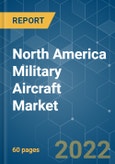The North America military aircraft market is anticipated to register a CAGR of over 4% during the forecast period (2020 - 2025).
Key Highlights
- North American countries, especially the US, has been at the forefront of developing advanced aerial assets to retain their air dominance. Thus, North America is enhancing its aerial combat capabilities both by upgrading the existing fleet of fighter jets, helicopters, and UAVs and procuring newer generation assets to phase out the ones nearing their end-of-life.
- Technological advancements, in terms of evolution and development of stealth technology in fifth-generation fighter jets such as the F-35 Joint Strike Fighter (JSF) and the X-47B, has ushered in an era of continuous research and development (R&D) to maintain a capability superiority over rival nations, such as Russia and China, who have indigenously developed similar aerial capabilities to counter the proliferation of the US’ influence on a global level.
Key Market Trends
Aircraft Platform to Dominate the Market
As of 2019, several fleet modernization programs are underway in North America. However, the aircraft fleet expansion and modernization programs contributed to a majority share of such undertaken initiatives due to their high induction rate and relatively higher pricing justified by their inherent sophisticated flight characteristics. The US indigenously developed the F-22, but due to certain limitations with designing a naval variant, the F-35 program was initiated. The F-35 can be configured into three variants: A, B, and C. As of October 2019, under the F-35 Joint Strike Fighter (JSF) Program, the US Department of Defense (DoD) was planning to acquire more than 2,400 new generation F-35s. Of the total acquisition, more than 1,700 aircraft shall be F-35A. Moreover, the F-35A is expected to replace the aging fleets of F-16 and the F-15 fighter aircraft. Similar potential procurement initiatives are anticipated to bolster the conventional take-off and landing segment of the market in focus during the forecast period.
United States to Dominate the Market During the Forecast Period
The US envisions leading the global arms race for military aircraft both in terms of numbers and capabilities. Thus, the US Air Force (USAF) possesses a different kind of aircraft for every task. Its combat aircraft are often considered to be its flagship assets as they are designed to be inherently capable of conducting various missions. Currently, the United States has over 1,800 combat aircraft in its fleet, and the US DoD is now focused on upgrading its combat aircraft fleet. Additionally, in March 2019, the USAF plans to increase its combat aircraft squadron from 55 to 65 in the coming years. Trials are currently ongoing for the XQ-58A Valkyrie demonstrator, a long-range, high-subsonic unmanned combat air vehicle (UCAV). The under-development XQ-58A drone and its derivatives are anticipated to perform a range of missions, including suppressing enemy air defenses, offensive and defensive counter-air maneuvers, nap-of-the-earth or terrain masking flight, and high-altitude flying. The US Army is also developing the Future Attack Reconnaissance Aircraft (FARA) and the Future Long-Range Assault Aircraft (FLRAA) along with other airframes as part of its larger Future Vertical Lift (FVL) initiative. Furthermore, the US Army is planning to field a new armed scout helicopter, dubbed the FARA, in the 2030s. The bidding companies, Lockheed Martin and Bell, are expected to deliver prototypes in 2023 for field testing. On this note, in October 2019, Bell unveiled its proposed single-rotor design of the '360 Invictus' for the FARA program. Thus, in terms of development and induction of new aerial assets, various ongoing developments are expected to bolster the growth of the market in the US during the forecast period.
Competitive Landscape
The North America military aircraft market is very competitive and requires active companies to align their product portfolio with the end users' evolving requirements. The market is also significantly influenced by the dispersion of modernization contracts to enhance the current fleet of active aerial assets' capabilities. The prominent players in the North America Military Aviation Market are Lockheed Martin Corporation, The Boeing Company, General Atomics, Northrop Grumman Corporation, and Textron Inc. The players compete in terms of a diversified product portfolio to offer advanced features at a competitive price point for winning the contracts awarded by the US DoD and the Canadian Ministry of Defense. For instance, in March 2020, Boeing had received USD 1.5 billion from the US Navy to produce the next 18 P-8A Poseidon aircraft. Also, in April 2020, Boeing agreed to produce KC-46 military aircraft for the USAF.
Additional Benefits:
- The market estimate (ME) sheet in Excel format
- 3 months of analyst support
This product will be delivered within 2 business days.
Table of Contents
Companies Mentioned (Partial List)
A selection of companies mentioned in this report includes, but is not limited to:
- The Boeing Company
- Lockheed Martin Corporation
- General Atomics
- Northrop Grumman Corporation
- Textron Inc.
- FLIR Systems Inc.
- Airbus SE
- Embraer SA
- Leonardo SpA
Methodology

LOADING...








